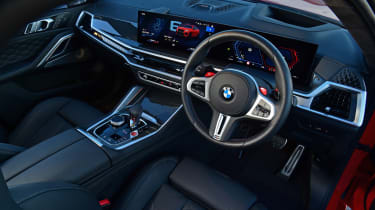New BMW X6 M Competition 2024 review: a brutal super SUV
The BMW X6 M Competition is a wildly fast, heavy and expensive car that some will love, and others hate…

Verdict
The BMW X6 M Competition makes little rational sense, but then no ultra-high performance SUV does. The ride is extraordinarily firm, so doesn’t make for a great everyday family car, but when the mood takes you, it drives with nearly as much talent as the sports saloons it tries so hard to emulate.
BMW M was early to the party when it first introduced the X6 M, beating pretty much all premium rivals to the super-SUV holy grail of profitability. Now, some three generations later, the X6 M Competition still plays by the same rulebook, but it’s a class that’s quickly changing as rivals from all directions close in.
The modern X6 M is available in this single high-spec Competition form starting at £126,050 – a decent chunk more than Audi’s less powerful RS Q8 (£109,360), but considerably less than a fully kitted-out Mercedes-AMG GLE 63 S Coupe (£144,850). In order to bump up the BMW’s spec to AMG’s level, you’ll need to sink another £16,100 into the X6’s ‘Ultimate Pack’. You can see why profits are so sizeable.
Under the bonnet, BMW M’s twin-turbocharged 4.4-litre V8 engine has been paired with a new mild-hybrid system in an attempt to reduce fuel consumption. But even with a light load on board we struggled to get near the official 21.8mpg figure.
Used - available now
Yet for those shelling out well over £100k, fuel costs aren’t likely to be a major worry. Probably of greater concern is performance; it’s worth noting that despite sharing its cubic capacity to the engine utilised in lesser BMW M models and even some Land Rover products, the Competition uses the high-spec ‘S63’ engine also found in the M5 and M8.
This means that 616bhp feels a conservative figure, often appearing like it’s capable of producing significantly more. Torque isn’t generally a strong point in the same fashion as an AMG engine, but the BMW rewards hard work, and gives something back at the higher end of the rev-band.
Power is sent through one of BMW’s typically slick eight-speed automatic transmissions, and like all full-fat M models has a unique gear selector that features the same gate as early M3s from the nineties fitted with an SMG transmission. Performance figures for the X6 are par for the course in this class, hitting 62mph in 3.9 seconds, but we doubt anyone would be asking for more power when that V8’s wound all the way up.
The X6 M features the same variable all-wheel drive system as the M5, although it doesn’t have the ability to decouple the front axle. Instead, the 4WD and 4WD Sport modes take care of business – the latter still putting a significant amount of power to the rear axle. It appears extremely well managed, with BMW M’s active locking rear differential managing things with all the alacrity of any M3 or M5, which is a very impressive feat.
This is all controlled through BMW’s usual M Driver Modes, with three basic setups in Road, Sport and Track, with each then able to be customised and saved into one of two M modes that are selected via a set of red toggles on the steering wheel. Within that frame of adjustability is the steering, engine, dampers, brakes, four-wheel drive torque split and the stability control, while the transmission’s three-stage variability in both its automatic and manual modes are operated separately from a switch on the gear selector.
So far, it’s all standard fare for a modern super SUV, but it’s BMW’s choices with the chassis that seem to be where the Competition diverges from most of the competition – no pun intended. That’s because, unusually for a car of this size, the suspension is made up from coil springs and standard dampers – in lieu of an air system. The X6 also does without some form of active anti-roll system and rear-wheel steering as found on the cheaper X6 M60i.
But once on the move, it’s clear to see why BMW M decided not to employ these elements, as it drives with a surprising amount of feedback, even for something pushing 2,400kg. The steering is much more feelsome and accurate than lesser X6 models, helping build a limited amount of confidence in fast corners despite being so far above the ground. The fact there’s a little bit of roll also reinforces this feeling, making it feel like a more natural and progressive car to drive quickly.
The flipside is that in order to control the weight so succinctly, BMW’s had to make the suspension especially firm, which in the UK, is a kiss of death. On smooth motorways, slow back roads or in town, it’s never anything other than uncomfortable, which feels like an odd compromise for something that is inherently designed to transport people from A to B.
It is worth noting, though, that firm is different to brittle, and the underlying resilience of the suspension, plus some generous side walls on the 21-inch front tyres, means it’s rarely jarring. In fact, with the driver’s settings all in their more aggressive tune, and the dampers slackened off, it does make a good fist at being quite the entertainer on a back road.
A special mention must also be made to the stability control’s middle MDM mode, which allows for a small amount of slip without leaving the driver completely on their own. It’s a brilliantly judged system – as it is in all BMW M models – and only reiterates that M does indeed know how to make any and all of its cars drive with a distinct sense of sportiness.
Looking up in the super-SUV class, Ferrari’s new Purosangue and the Aston Martin DBX707 both drive with even more poise and engagement, but these two cars are considerably more expensive than the BMW, while also finding their origins in bespoke platforms – rather than ones that need to be shared up and down model ranges.
So when it comes to sophistication or variability, direct rivals like the aforementioned Audi and Mercedes or even the Porsche Cayenne Turbo S E-hybrid sit more comfortably with their mandate as being fast family transport. The BMW, however, seems to have thrown caution to the wind and created something that drives as closely to an M5 as possible regardless of compromise to ride quality or economy. So if that’s what you’re after, the X6 M Competition has you covered.
| Base price: | £126,050 |
| Price as tested: | £143,155 |
| Engine: | 4.4-litre V8, turbocharged petrol |
| Power/torque: | 616bhp/750Nm |
| Transmission: | Eight-speed dual-clutch automatic, four-wheel drive |
| 0-62mph: | 3.9 seconds |
| Top speed: | 178mph |
| Economy/CO2: | 21.8mpg/291g/km |
| L/W/H: | 4,948/2,212/1,695 |
| On sale: | Now |









